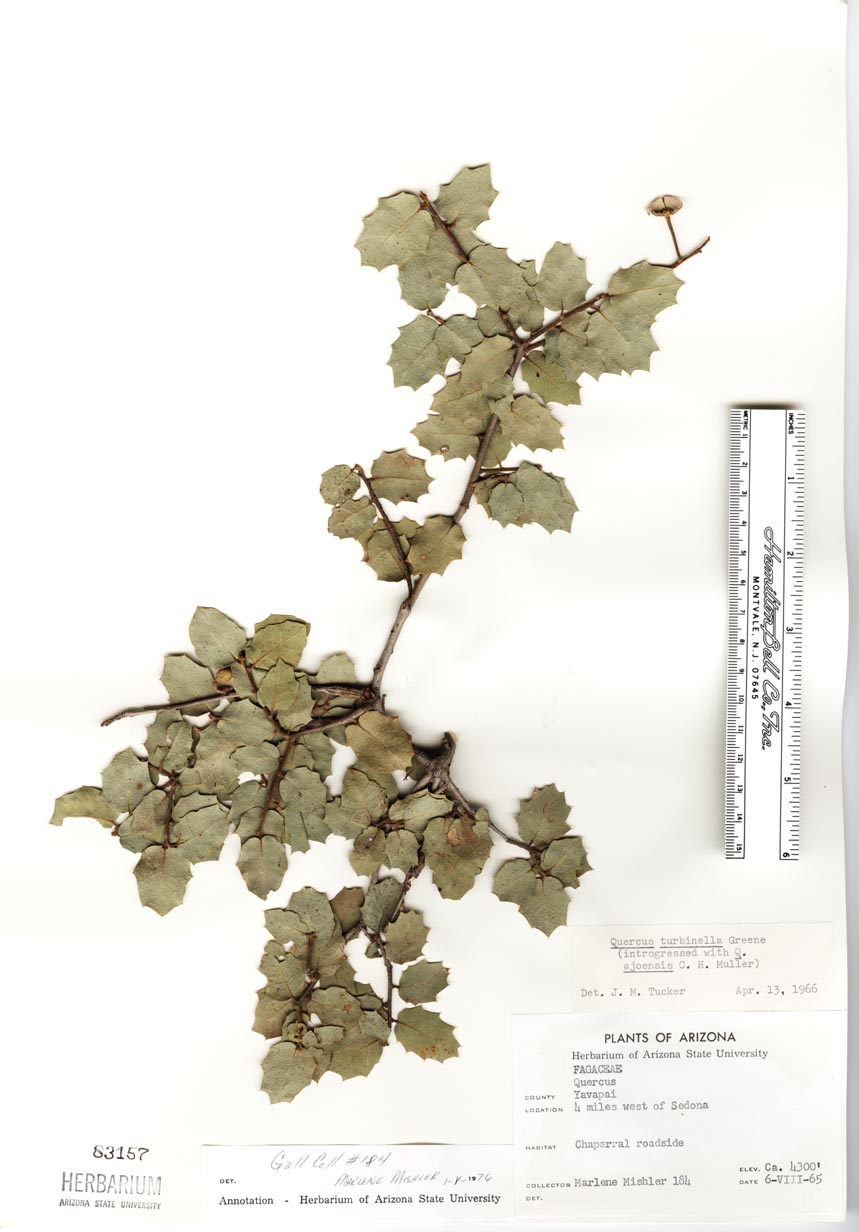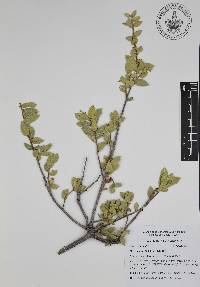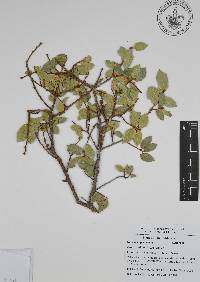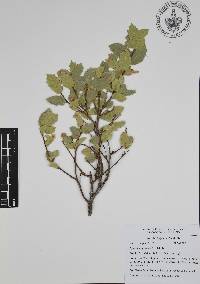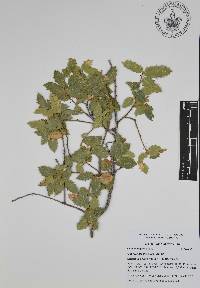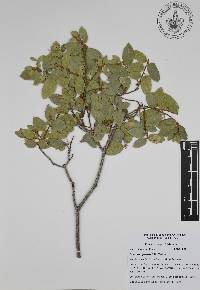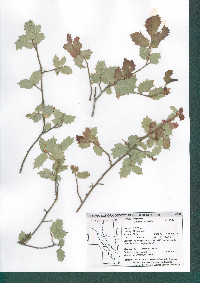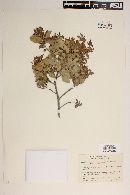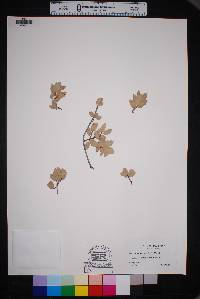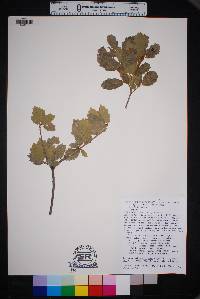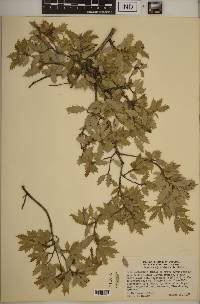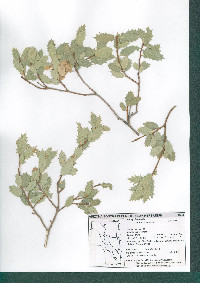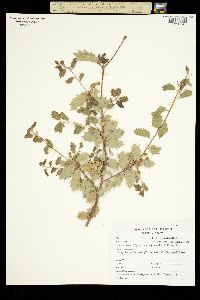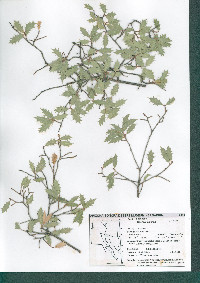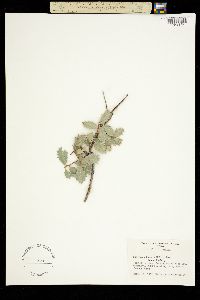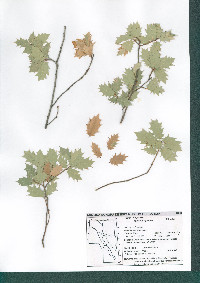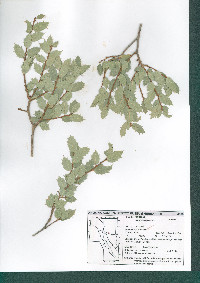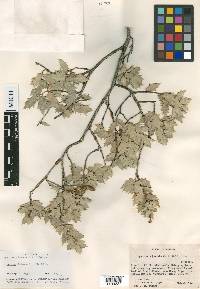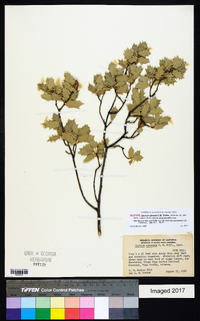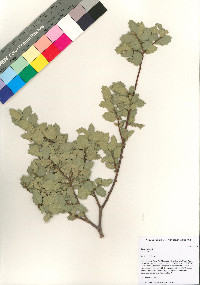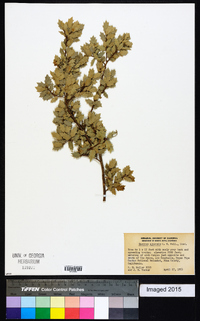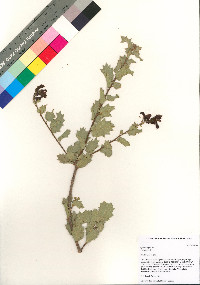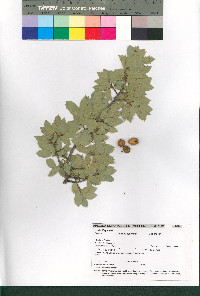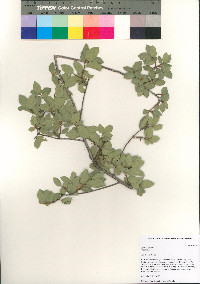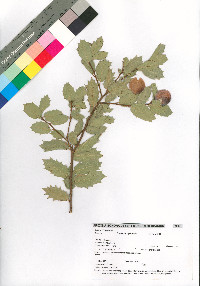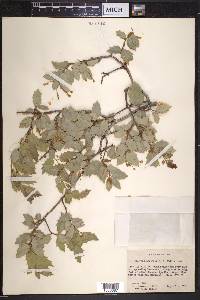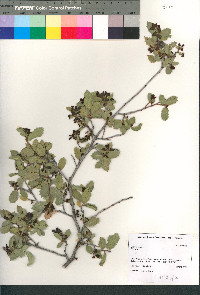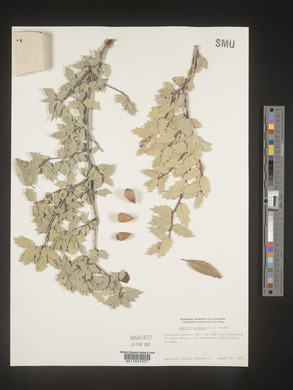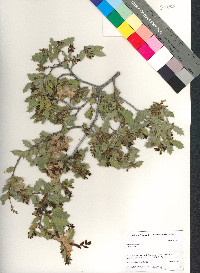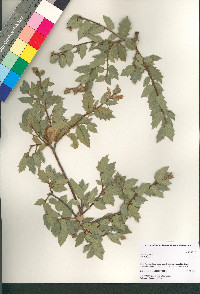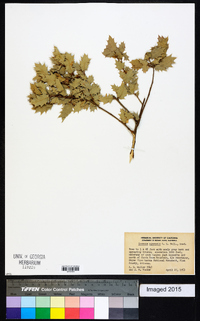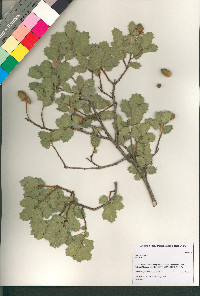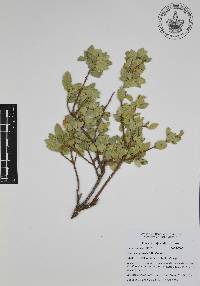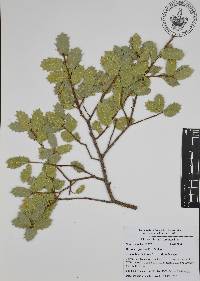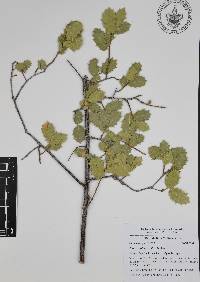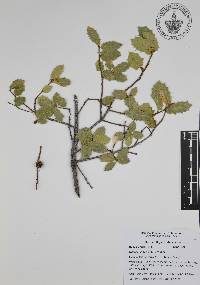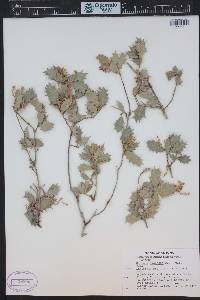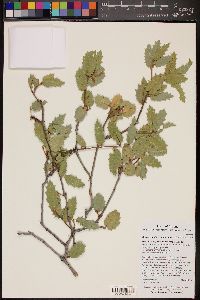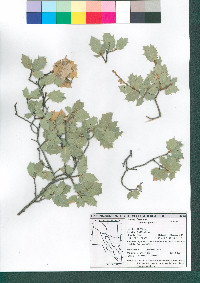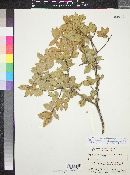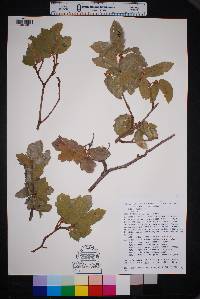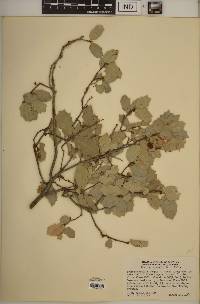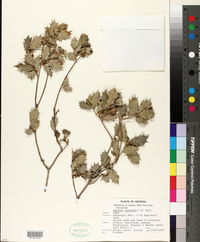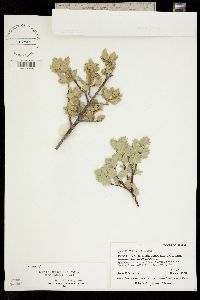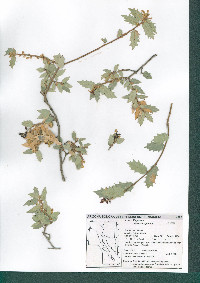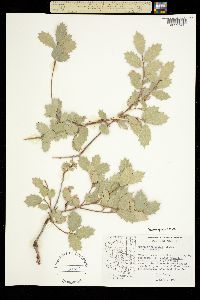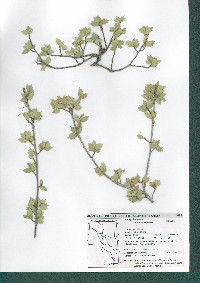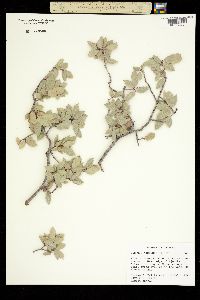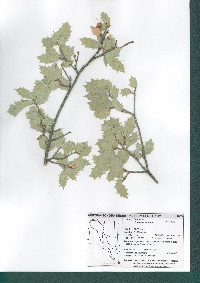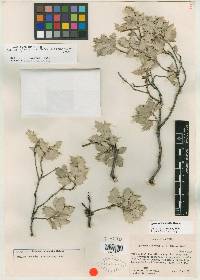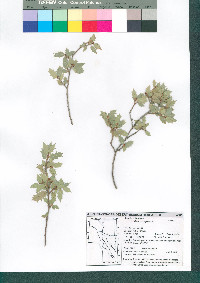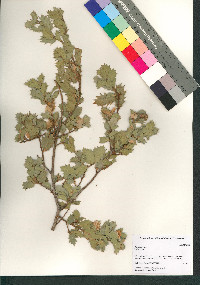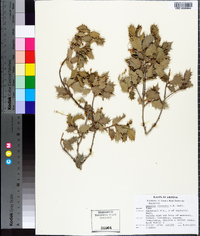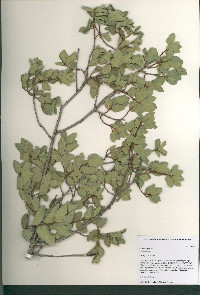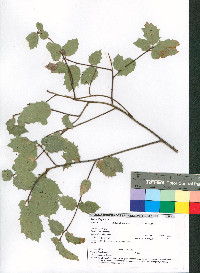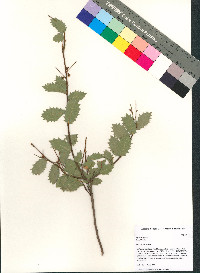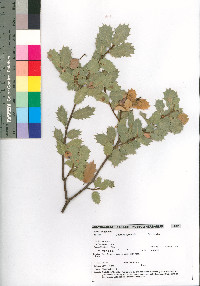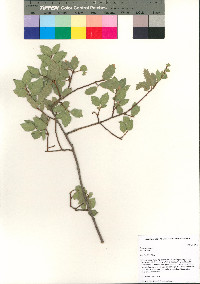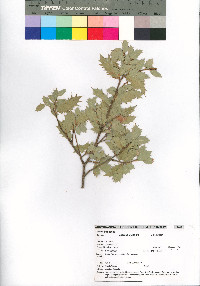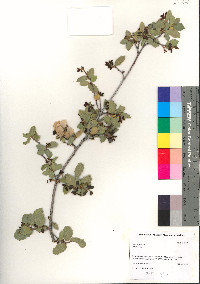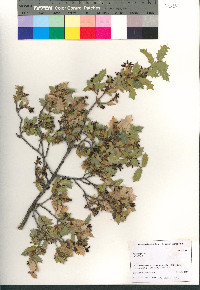Quercus ajoensis
|
|
|
|
Family: Fagaceae
Ajo Mountain Oak, more...Ajo Mountain scrub oak, ajo oak, shrub live oak
[Quercus turbinella subsp. ajoensis (C.H. Muller) Felger & Lowe, moreQuercus turbinella var. ajoensis (C.H. Muller) Little] |
Shrubs, rarely trees , evergreen, to 2-3 m. Bark gray, scaly or furrowed. Twigs light brown, 1-2 mm diam., inconspicuously short stellate-pubescent or glabrate. Buds brown or reddish brown, ovoid or globose, 1-1.5 mm, variously short stellate-pubescent, tomentose, or glabrate. Leaves: petiole (2-)3-4 m. Leaf blade ovate to narrowly ovate or oblong, (10-)15-35(-50) × (5-)10-20(-30) mm, rather leathery, base cordate, rarely rounded, margins crispate, sometimes flat, cartilaginous, with 4-6(-8) long-attenuate, spinose-awned teeth on each side, secondary veins 5-8 on each side, whitish, apex acute or obtuse with bristly distal teeth; surfaces abaxially blue-green, waxy-glaucous, microscopically papillose, glabrous, sometimes sparsely stellate-pubescent along midrib, adaxially blue-green, glaucous, glabrous or sparingly stellate-pubescent along midrib, secondary veins raised on both surfaces. Acorns solitary or paired on thin axillary peduncle (5-)30-50 mm; cup shallowly cup-shaped, thin, 3-4 mm deep × 6-8(-10) mm wide, enclosing only base of nut, scales brownish, moderately tuberculate, pubescent; nut oblong to narrowly ovoid, 12-15 × 5-8 mm. Cotyledons distinct. Flowering in spring. Rare to locally abundant on igneous slopes; 500-1500 m; Ariz.; Mexico (Baja California). Populations of Quercus ajoensis in southern New Mexico show characteristics suggesting introgression from hybridization with Quercus toumeyi , such as increased twig and leaf pubescence and sometimes the prominent golden puberulum of the abaxial leaf surfaces. Hybrids between Q . ajoensis and both Q . turbinella and Q . gambelii (Utah) are also known.
FNA 1997, Wiggins 1964 Common Name: Ajo Mountain scrub oak Duration: Perennial Nativity: Native Lifeform: Shrub General: Erect shrubs or low trees 2-3 m, evergreen, bark gray, scaly or furrowed, with young twigs pubescent. Leaves: Leaves ovate, leathery, with crispate, toothed margins, with 4-6 teeth, each bearing spines, shiny and blue green on the uppermost surface, sometimes slightly pubescent beneath, secondary veins raised on both surfaces. Flowers: Staminate catkins 2-4 cm long, with tomentose peduncles, the pistillate peduncles 1.5-7 cm long, nearly glabrous. Fruits: Acorns solitary or paired, 6-8 mm in diameter, 3-4 mm high, with shallow cup, enclosing only the base of the nut, cup scales brownish, warty, pubescent and thin, the nut oblong to narrowly ovoid, usually maturing in one season. Ecology: Found on igneous substrates on slopes, can grow in patches, from 1,500-5,000 ft (457-1524 m); flowers in spring. Distribution: sw AZ from Yuma to Pima County. Notes: Q. ajoensis is known only from southern Arizona. It is similar to the more widespread scrub oak, Q. turbinella, and has been treated as a variety of that species. Benson and Darrow note that intermediates between this Q. ajoensis and Q. turbinella var. turbinella have been found in the Kofa and Castle Dome Mountains in Yuma County, AZ. Look for the ovate or oblong and leathery leaf, 15-35 mm long, with 4-6 teeth on each side. The marginal teeth on the leaf are 2 mm long (vs. <1 mm in Q. turbinella var. turbinella); the leaves are hairless or with a few stellate hairs on the midribs, and the lower surfaces are conspicuously glaucous with fine beads of bluish wax (leaves grayish- or tawny-pubescent and not at all glaucous in Q. t. var. turbunella) and acorns are 1/2 to 5/8 inch long (acorns slightly larger in var. turbinella, at 5/8 inch- 1 inch long). Ethnobotany: Unknown Etymology: Quercus is the classical Latin word for oak, thought to be derived from Celtic quer, fine, and cuez, tree, ajoensis means of or from Ajo, where the type location is found in the Ajo Mountains near Organ Pipe Cactus NM. Synonyms: Quercus turbinella var. ajoensis, Quercus turbinella subsp. ajoensis Editor: LCrumbacher, 2011 |

